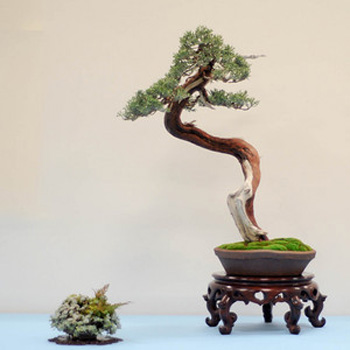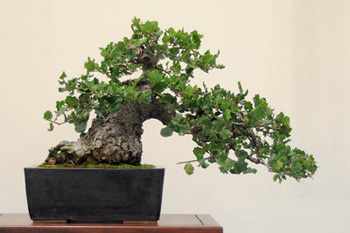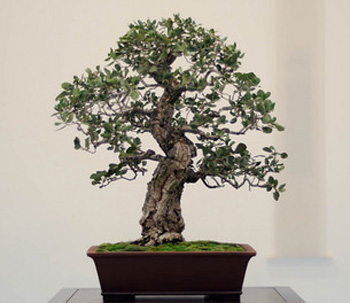
I lifted this sinuous Ponderosa pine (Pinus ponderosa) off of a great gallery at Bonsai Tonight from the 2010 Bay Island Bonsai Exhibit. Though I can’t tell for sure, it looks like at least five full twists in the trunk. Not something you see every day.

Here’s another heavy-trunked bunjin. It’s a Sierra juniper, also known as Western juniper (Juniperus occidentalis). It and it’s close cousin, the California juniper (J. californica) are becoming favorites of bonsai enthusiasts here and abroad.
Natives
It’s good to see is the use of native trees and their increasing acceptance as subject for high quality bonsai. I can remember a day when almost all specimen bonsai were Japanese varieties (for that matter, almost all were by Japanese bonsai artists – not counting Penjing, that is). Because the Japanese varieties set the standard, recognition of other varieties as potential subjects for world class bonsai has taken some time.
The risk of depletion
All of the trees shown here were collected from the wild (or so it appears). In Japan almost all of specimens worthy of collecting have long been dug up. Could that happen here?

California live oak (Quercus agrifolia). Another native tree with numerous features that make for great bonsai. In some ways it reminds me of the ancient olives that are everywhere in Spain, and that make such great bonsai. Like those olives, live oaks are abundantly omnipresent in much of California.

This one is labeled Cork oak, but should be distinguished from the actual Cork oak (Quercus suber) that wine corks come from, which is a European native. Though the photo is too small to tell for sure, I’d bet that it’s a California live oak that has ‘corked up’ with age. These corky live oaks are often called cork oak in California (by bonsai enthusiasts at least). If you look at the live oak above, it appears to be corking up some too.
Want more?
Bonsai Tonight has a bunch of great shots from Bay Island Bonsai‘s 11th Annual Exhibit. As of now, none of the artists names appear with the trees. I imagine that will change when Bay Island puts them up on their site.
Gorgeous trees.
Here in the Western U.S., I think we have a fairly inexhaustible supply of wild trees, but not all of it is collectible. For one thing we have more wild real estate than Japan. And also, some of our best collectors strike deep into the wilds to find the best stuff, rather than grabbing everything in sight.
I’m pretty sure the second oak is Quercus suber. I have one with very similar bark. The older agrifolias that develop bark like that, I am pretty sure, attain greater girth before doing so, and the fissures in agrifolia bark are much darker than that of suber.
Al Polito
crackpot horticulturalist and rank amateur bonsaiman
Hi Al,
Thanks and I imagine there is some truth to the supply of collectible trees, especially if people are smart about it and don’t grab everything in site. Westerners are lucky when it comes to collecting, back here the pickings are much slimmer. If it weren’t for larch it’d almost be too slim to bother, at least here in northern Vermont.
I hoping you would set me straight on the cork oaks. I do know Q suber has been introduced to the US and has no doubt escaped into the wild, so why not? With photos it’s often hard to tell, but if it is a suber, then they look a lot like Calif live oaks.
From a distance, yes, agrifolias and subers look a lot alike. Especially the big subers. I’ve never seen them colonize the wilds though, although they could perhaps. There are just SO MANY agrifolias in California, so much so that if someone wanted an oak in their landscape, there was probably an agrifolia already there, plus they grow very quickly in their native environment—probably faster than suber. (Honestly, I just got my suber bonsai last summer from a bonsaiman in SoCal and I’m just learning about its care and habits.) Agrifolias from what I can tell tend to sprout suckers, branches, etc. more readily from old wood than do subers.
So you don’t think that the suber in this post was collected? Sure looks like a collected tree, but then strange things can happen in S. Cal with the near eternal growing season and plenty of people who know how to grow material for bonsai.
Though both Juniperus occidentalis, Western Juniper and Sierra Juniper are not the same tree.
http://en.wikipedia.org/wiki/Juniperus_occidentalis
Yeah. Apparently there are two subspecies of J. occidentalis. Thanks for the heads up.
Actually, the juniper situation in California is even more complicated. The latest word on it is in Robt. P. Adams’ book on Junipers of the World: The genus Juniperus, 2nd edition (2008), available from Trafford Publishing in Vancouver (more cheaply there than from any other source, last time I checked).
Yeah. Things can get complicated. Humans and nature keep messing around and blurring lines between species. Guess I’ll have to get my hand on that book. Thanks for the heads up.
The bottom oak is in fact a cork oak and not a Live oak. This was grown by seed and belongs to Mr. Oak himself.
Thanks for the clarification Jeff,
Though you might argue that a cork oak is a live oak, at least in the broad usage of live oak as any evergreen oak.